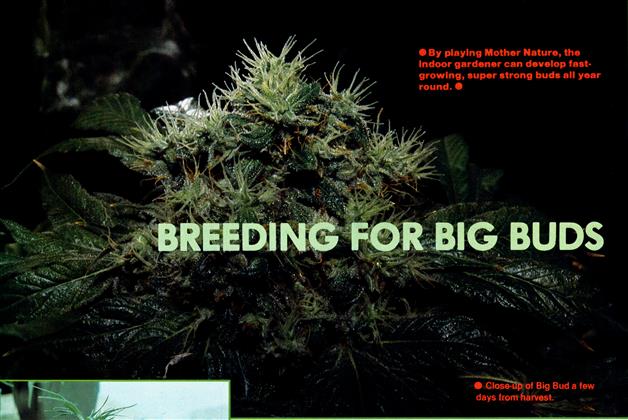featured
BREEDING FOR BIG BUDS (1986)
Published
13 hours agoon

Original publication: November 1986.
BREEDING FOR BIG BUDS
HARVEST ’86
BY JORGE CERVANTES

“Look at the size of that thing, I must be hallucinating,” said Tim as he stared in awe at the huge six-inch diameter flower top. “What did you put in this joint to make me see things twice as big as life? I mean, that is the biggest bud I’ve ever seen!”
“We call her Big Bud. I think she is 100% Indica,” replied James with a big smile. “I brought her back to Detroit from out West. Here, give her a try,” said James, passing Tim a bomber of Big Bud.
Tim put the spliff between his lips and gently drew a few breaths through the unlit joint. “So fresh and minty, it’s the best I’ve ever tasted. I take back all the bad stuff I said about indoor smoke,” Tim said with a pleased sheepish grin.
“They’ve been breeding some incredible plants out on the West Coast. When I was there, indoor growers were talking about the Hash Plant that matures into a 36″ tall two-three ounce plant (dried tops only) after eight weeks of flowering: stout, broad tops laden with thick gooey resin. Or Lime Bud, a Sativa/lndica cross, with long, dainty, lime green leaves and lightweight buds packed with pistils and glistening resin glands. Or Northern Lights, a mainstay variety in Vancouver, B.C. that matures into a four-foot, four ounce plant at the ripe old age of 85 to 90 days. But everyone’s favorite is Big Bud because she grows huge buds and has the sweetest, mintiest taste in the world. My last crop weighed in at 3 1/2 pounds, that’s better than four ounces a plant!”

Narrow leaves show classic qualities.
All of these varieties were developed by industrious, careful and caring individuals that have kept meticulous detailed records of plant growth habits and the offspring that resulted when they crossed a male plant with a female. Indoor breeding is two or three times faster than outdoors. As many as three generations may easily be completed in one year indoors. The breeder controls the hours of light and darkness per day, causing the plants to flower and produce seed at will.
Selective breeding (also known as selective sexual propagation) has completely changed the quality and yield of indoor marijuana crops. The starting point is to collect marijuana seed from well known pot growing regions throughout the globe. The various seed strains are grown and studied thoroughly without any cross breeding. Once each is understood, then selective breeding can begin, either to attain a pure seed stock, or to improve the strain. Once the ultimate plant is developed through this sexual propagation, it can be cloned to preserve the genetic blueprint created by selective breeding.
Cannabis Indica seeds are highly prized for their potency and adaptability to the indoor environment. The characteristics of Indica plants include: squat, bushy, vigorous growth; early, sustained potency; disease resistance; and heavy bud yield. An Indica plant may yield two to four times the dry bud weight of a Sativa at harvest. Thai, Colombian, and Mexican are examples of Cannabis Sativa. These Sativa varieties are tall, lanky, and disease resistant, with narrow, long leaves and light buds that take up to three months to mature. But the high is energetic, soaring, and clear.
Ideally, skilled breeders will strive to retain the desirable dominant growth characteristics of both Cannabis Sativa and Cannabis Indica to form super strains. Breeders may cross a Sativa with an Indica, hoping to retain the desirable soaring high while keeping the short, stocky growth characteristics and early maturity of the Indica.

This single indica female bud is being fertilized by male pollen in the plastic baggie.
Selective breeding requires the breeder to simply assume the role of Mother Nature once again. In nature, pollen from the male cannabis plant is shed into the wind to randomly fertilize any receptive female plant. A breeder adds precision and control to this process by catching pollen from a desirable male and carefully placing it in contact with chosen female pistils.
Two basic kinds of breeding are: (1) inbred or true bred—plants of the same strain or ancestry that are crossed with one another. (2) outbred or hybrid— plants of different strains that are crossed or cross-pollinated.
The goal of inbreeding is to establish a pure breed to start from. Selected females are pollinated with male pollen of the same strain, then the resulting seeds are planted and checked for variability. This process may take several generations to produce a strain that actually breeds true. Pure bred plants are grown until the fifth to sixth generation, after which negative characteristics, like low potency, legginess and lack of vigor tend to dominate.
This true or pure breed is essential to establish common growth characteristics. Without a pure breed on one or both sides, it is difficult to predict the outcome of a hybrid cross. Ideally, both male and female are pure-bred plants, with known ancestry and growth attributes.
A hermaphroditic plant (a plant displaying both male and female flowers) will self-pollinate and produce inbred seeds. Although this is a shortcut to inbreeding, the seedlings resulting from self-pollination may tend to be hermaphroditic themselves. This can be a real headache for the sinsemilla grower or breeder, with unwanted seeds and uncontrolled pollen. Nonetheless, the seed produced by a hermaphrodite that has just a few male flowers on a female plant will be 80-90% female seed. One easy way to produce seeds from an all female clone crop is to stress one of the female branches by twisting a piece of wire around one of the branches a couple of weeks before flowering is induced. The extra stress will usually cause the plant to produce male flowers.
Outbreeding, or producing hybrid seed, has increased agricultural production more than anything. Farmers, breeders and cannabis horticulturists have found that crossing parents of different pure strains, especially those exhibiting exceptional, dominant, complementary characteristics, will result in a super plant, also referred to as hybrid vigor.
It is possible to cross Sativa/lndica. Some growers swear by the cross, saying you get the best of both plants: vigor and size from the Sativa, and squat, bushy, early, potent growth from the Indica.
Choosing from a large and varied plant stock is the key to successful breeding. Since the origin of most seed is dubious, an accomplished breeder waits to see what kind of plant it produces, before deciding which plants to cross to form hybrid seed. If the breeder plants only a few seeds, there is no guarantee that they will grow into ideal breeding stock, even if they came from dynamite smoke. If the breeder instead selects the best plants from many seedlings of various strains of Cannabis Indica (and/or Sativa), he or she will have a better chance of achieving the desired outcome.
BREEDING: STEP-BY-STEP
STEP ONE: Choose male breeding stock exhibiting desirable characteristics.
STEP TWO: One branch full of male flowers is all that will be needed, unless a large crop is desired. Unused branches may be stripped of flowers to help contain pollen and guard against accidental, random pollination. The male can be isolated from the females, once flowers have developed, but not yet opened, by placing him in a sunny window or in a vegetative grow room. This will slow flower development and not hurt the male in any way.
A branch of ripe, male flower may be cut and placed in water. It will remain healthy for several weeks. When the pollen sacks open, proceed with Step Three. The remaining male plant may then be cut back or harvested.
Skilled breeders will cross a Sativa with an Indica, hoping to retain the Sativa’s soaring high while keeping the stocky growth and early maturity of the Indica.
STEP THREE: When the pollen pods start to open, place a clean, plastic sack or baggie over the branch to collect pollen. Secure the bag at the bottom with a piece of string or wire tie. Keep the bag over the branch for several days to collect pollen.
STEP FOUR: When enough pollen has been collected, shake remaining pollen off into the bag. Remove spent branch. Pollen may be kept for several weeks by removing all vegetative matter to prevent mold, and storing the pollen in a dark, dry container in the refrigerator.
STEP FIVE: Ideally, pistils should be ready for fertilization three to four weeks after the first calyx has appeared. Receptive pistils are white and fuzzy, not starting to turn brown. Cover the selected female branch that has many ripe, receptive pistils with the pollen-filled bag. Shake the bag.
STEP SIX: Use a small paint brush to apply the pollen from the bag to the pistils if just a few seeds are desired from many different females. Be very careful. Just use a little pollen on each calyx and keep it from spreading to the sinsemilla crop.
STEP SEVEN: Leave the bag for two or three days, to ensure fertilization. Be careful not to scatter pollen on adjacent sinsemilla crop when removing the bag.
STEP EIGHT: After fertilization, seeds will be ripe in three-six weeks. Harvest seeds when they split open the containing calyx or rattle in the pod.
STEP NINE: Let seeds dry for two to three months, in a cool, dry place, before planting.
This is the eighth in a series of articles by Jorge Cervantes, author of the bestselling INDOOR MARIJUANA HORTICULTURE, known by many as the Bible of indoor growing. The series outlines indoor growing from A-Z, for both novices and experienced gardeners alike.

Author: mscannabiz.com
MScannaBIZ for all you Mississippi Cannabis News and Information.
You may like
-


Goldflower Cannabis Opening 9th Florida Dispensary in Bonita Springs
-


Inside Morocco’s Cannabis Culture and Legal Industry Shift: From Kif to Clinics
-


Ky. Governor urges President Trump to oppose blocking cannabis rescheduling
-


Gap in cannabis education leaves medical providers in the dark
-


FDA Commissioner Links Use Of Cannabis Products To Heart Problems And Psychosis
-


New York Cannabis Regulators Messed Up Dispensary Location Guidance; 152 Stores Impacted
featured
Goldflower Cannabis Opening 9th Florida Dispensary in Bonita Springs
Published
8 minutes agoon
July 29, 2025
[PRESS RELEASE] – ORLANDO, Fla., July 29, 2025 – Goldflower Cannabis, one of Florida’s fastest-growing vertically integrated cannabis companies, announced the opening of its newest dispensary located at 24830 S Tamiami Trail, Bonita Springs, Fla., 34134, projected to debut on Aug. 30, 2025.
This marks another milestone in Goldflower’s rapid statewide expansion—following recent openings in Miami and Orlando—and the beginning of an even stronger presence in Southwest Florida.
Highlights of the Bonita Springs location include:
- Premium Cannabis Products: Stocking a full suite of flower, solventless concentrates, premium edibles, tinctures, topicals and pre-rolls, including the flagship Ideal Cannabis line cultivated under organic-style practices.
- Educational and Community Focus: Staffed with trained budtenders and featuring an inviting lounge space, visitors will also enjoy ongoing “Meet the Grower/Maker” events that connect patients to the cultivation and production process.
- Luxury Retail Experience: The dispensary embodies Goldflower’s signature boutique aesthetic—curated materials, open yet discreet storefront, intimate consultation areas, and a design-forward Flower Bar showcasing premium products.
Goldflower Cannabis operates multiple medical marijuana treatment centers across Florida—from Miami to Orlando—built on a vertically integrated model that spans cultivation, extraction, product manufacturing and retail. The company is known for its unwavering commitment to purity, patient education and world-class service delivered in beautifully designed environments.
“Bonita Springs is a natural and very strategic next step for us,” Goldflower Cannabis President Angelo Lombardi said. “We’ve always believed that cannabis retail should be warm, welcoming, and genuinely helpful—especially in communities like Bonita that value wellness and connection. Bonita Springs is the closest city to Naples that allows cannabis, and as such, is a very strategic site for us to serve not only the city but the residents of Naples seeking cannabis for wellness. It also adds another site to our growing presence on Florida’s west coast with dispensaries already in Largo, St. Petersburg, Tampa, Bradenton, now in Bonita Springs and Cape Coral to open before the end of the year.”
Goldflower’s Bonita Springs location will join its existing dispensaries in Miami and Orlando (which opened earlier this summer), Bradenton, Largo, St. Petersburg, Ocala, Sebring and Tampa, with additional locations planned in Lakeland, The Villages, Cape Coral, Orange Park, Tallahassee, Gainesville and Punta Gorda.
For more on Goldflower Cannabis, and to be kept up to date with opening news and brand developments, visit: goldflowerfl.com.

Author: mscannabiz.com
MScannaBIZ for all you Mississippi Cannabis News and Information.
featured
Inside Morocco’s Cannabis Culture and Legal Industry Shift: From Kif to Clinics
Published
1 hour agoon
July 29, 2025
Nestled in the misty hills of Morocco’s Rif Mountains, a centuries-old cannabis culture is undergoing a profound transformation. Long famed for its golden hashish, smoked across Europe and beyond, Morocco is now walking the tightrope between tradition and regulation, between kif and clinics.
This North African kingdom, once the world’s top exporter of illicit hash, is trying to rebrand itself as a leader in the legal medical and industrial cannabis space. But the journey is anything but smooth.
A Brief History of Moroccan Cannabis
The story of cannabis in Morocco spans over a thousand years, intertwining spirituality, colonization, rebellion, and rural survival. What began as a mystical herb used in Sufi rituals evolved into a cornerstone of one of the world’s most prolific hashish economies.
Origins: From the Silk Road to the Rif
Cannabis likely arrived in Morocco sometime between the 10th and 15th centuries, brought by Arab merchants, Andalusian refugees, or through contact with Persian and Indian traditions during the Islamic Golden Age. The plant took root in the fertile valleys and slopes of the Rif Mountains, a remote and rugged region in northern Morocco, perfectly suited for clandestine cultivation.
The plant quickly gained cultural significance. Among Sufi mystics, kif was used in dhikr (remembrance of God) ceremonies to enhance spiritual insight and reach ecstatic states. In rural Berber villages, it became an integral part of social life shared over long conversations, music, and mint tea. Rather than a drug, kif was a ritualized experience, always consumed communally in sebsi pipes.
Colonial Era: Legalization and the Roots of the Hashish Trade
During the late 19th and early 20th centuries, Morocco came under French and Spanish colonial rule. The colonial powers adopted vastly different approaches to cannabis.
In 1917, the Spanish administration officially legalized cannabis farming in its northern protectorate, including the Rif region. This wasn’t a progressive drug policy; it was a way to pacify tribal leaders and maintain political control. Cannabis was permitted in certain areas under license, especially in Ketama, which would later become the hash capital of the world.
Meanwhile, the French were more restrictive in their southern zones, but enforcement was uneven. The colonial era allowed kif to flourish under the radar, and local farmers increasingly refined their knowledge of cultivation and processing.
By the early 20th century, Moroccan hashish was already making its way across the Mediterranean, especially to France and Spain, where it gained a niche following among bohemians, expatriates, and soldiers.
Post-Independence: Prohibition Meets Tolerance
In 1956, Morocco gained independence from colonial rule. One of the new government’s first acts was to ban cannabis nationwide, attempting to align with international drug conventions and present a modern image.
But the ban came with a massive caveat: cultivation continued, unofficially tolerated in the Rif Mountains, largely for political and economic reasons. The Rif region had long been marginalized by the central government, and cannabis cultivation was often the only viable income in the mountainous terrain.
In this gray zone of tolerance, cannabis cultivation exploded. What had been a spiritual and social tradition turned into into a massive cash crop, smuggled across Europe via Spain. By the 1980s and 1990s, Morocco was producing over 3,000 tons of cannabis resin per year, according to UN estimates, making it the world’s top exporter of hashish.
The Hippie Trail and Global Recognition
The 1960s and ’70s brought a new wave of cannabis culture to Morocco. Western backpackers and hippies, traveling the famed “Hippie Trail” from Europe to India, passed through Morocco and discovered its legendary hash.
Places like Chefchaouen, with its blue-washed walls and mountain backdrop, became cannabis tourism hubs. Foreigners flocked to Ketama for its hashish, often staying in local homes, helping with the harvest, and learning the art of kif from seasoned Berber growers.
Moroccan hashish, soft, golden, and potent, became a fixture in Amsterdam coffee shops, Paris cafes, and British music festivals. It was a brand without needing a label.
Crackdowns and Erasure (1990s–2010s)
Under pressure from international drug enforcement agencies, particularly from Europe, the Moroccan government began periodic crackdowns on cannabis production starting in the late 1990s.
Fields were burned. Farmers were arrested. Alternative crops like figs and olives were promoted. But the economic dependency on cannabis was too deep and the mountainous terrain too difficult to police effectively.
At its peak, an estimated 800,000 Moroccans, around 10% of the population, were economically tied to the cannabis trade. Efforts to dismantle the industry often backfired, leading to increased unemployment, resentment, and migration from rural areas.
Despite the risks, cannabis remained the unofficial lifeblood of the Rif.
The Shift to Legalization (2021–Present)
In 2021, the Moroccan government passed Law 13-21, marking the country’s first formal recognition of cannabis as a legal industry. The law legalizes the medical, cosmetic, and industrial use of cannabis, placing Morocco in line with global cannabis reforms.
Legal cultivation is now overseen by ANRAC, and registered farmers must join approved cooperatives and obtain licenses. Though intended to empower local farmers and undercut criminal networks, the rollout has faced bureaucratic hurdles, pricing challenges, and resistance from legacy growers.
Still, the law represents a radical pivot in Moroccan cannabis policy, shifting from back-alley crackdowns to regulated fields, with the potential for export markets and pharmaceutical partnerships.
What Makes Moroccan Cannabis Culture Unique?
To understand Morocco’s cannabis future, you have to appreciate its past. In the Rif Mountains, cannabis is not simply a crop or a commodity. It is part of the cultural fabric. Known locally as “kif,” it has been consumed for centuries in ceremonial, social, and spiritual settings. Kif is often smoked in a long, narrow wooden pipe called a sebsi, accompanied by conversation, mint tea, or music. Among Sufi mystics, kif was sometimes used to enhance spiritual practices such as chanting and trance-like meditations. In rural homes, it became part of the rhythm of life, shared communally and without stigma.
What sets Moroccan cannabis culture apart is the traditional process of hash-making, which has evolved into a specialized artisanal craft. After harvest, cannabis plants are dried and then carefully beaten over silk screens to separate the trichomes. This fine powder, called kief, is then pressed using heat and manual techniques into hashish blocks. The resulting hash varies in color and quality, with Morocco’s iconic “blonde” hash prized across Europe for its smooth texture and balanced effects.
Beyond the ritual and craft, the cannabis economy has been a pillar of survival for tens of thousands of families in the Rif region. With little access to state support or modern infrastructure, entire villages have relied on cannabis as their primary source of income. It funded education, home repairs, and even migration to cities. For many, cannabis was never about counterculture rebellion or Western-style recreation. It was about feeding families and maintaining dignity in the face of economic neglect.
In this way, Moroccan cannabis culture is deeply rooted, fiercely local, and shaped by generations of resilience. It is not just a legacy of agriculture, but a way of life tied to the land, the people, and their collective memory.
Legalization: A New Chapter
In 2021, Morocco passed Law 13-21, which legalized cannabis for medical, cosmetic, and industrial use. The move came in response to international legalization trends—and years of pressure from European governments facing hashish smuggling at their borders.
The government established ANRAC (National Agency for the Regulation of Cannabis Activities) to oversee the industry. Farmers must now register cooperatives, obtain licenses, and sell only to government-authorized buyers.
2025 Snapshot:
- 5,000 farmers registered with the legal cannabis program (up from 430 in 2023).
- Nearly 4,200 tonnes of legal cannabis were cultivated in 2025.
- 5,800 hectares under legal cultivation—but 27,000+ hectares still producing illegally.
- The price paid to legal farmers: 50 dirhams per kilogram of raw plant.
- The illicit market price for hashish: 2,500 dirhams per kilogram.
The Challenge: Illicit Market Still Dominates
Despite the legal rollout, the illicit market remains king. The math is simple. Legal cannabis pays pennies. Illegal hash pays bills.
Legalization has brought freedom to some growers. Farmers like Abderrahman Talbi, interviewed by Reuters, now grow without fear of raids. “Peace of mind has no price,” he says. Others, like Mohammed Azzouzi, recently received royal pardons for prior offenses and are preparing their first legal harvests.
But many cultivators are hesitant to switch. The red tape is thick, payments are slow, and the pricing makes legal farming barely sustainable. With demand for Moroccan hash still strong in Europe, thousands remain committed to the illicit trade.
Medical, Not Recreational
While countries like Germany, Canada, and several U.S. states explore full recreational markets, Morocco is firm: recreational use is still banned. According to ANRAC head Mohamed Guerrouj, the country’s focus is purely pharmaceutical and industrial. Talk of cafes and dispensaries remains a distant fantasy for now.
Still, critics argue that without opening up the recreational space, the country won’t effectively displace the illicit market. The restrictions may stifle Morocco’s ability to compete with global producers like Colombia, Canada, or Thailand.
The Future of Cannabis in Morocco
Morocco has the terroir, the history, and the generational expertise to become a global leader in cannabis. Its climate is ideal, its farming knowledge is unmatched, and its hashish has long been regarded as some of the finest in the world. But for the legal cannabis industry to truly thrive, Morocco must confront the disconnect between well-intentioned regulation and on-the-ground realities.
To move forward, the government must simplify licensing procedures and ensure payments are made efficiently to participating farmers. Current bureaucratic delays and low pricing discourage transition into the legal system. If legal cannabis is to compete with the illicit market, farmers need economic incentives that reflect the value of their labor and product.
A national conversation about controlled recreational use may also become necessary. While Morocco’s current framework limits cannabis to medical and industrial applications, opening the door to adult-use could help legitimize more of the existing economy and offer new streams of tax revenue and international trade.
Just as important is the preservation of traditional hash-making techniques and cultural heritage. The government’s success will depend not only on its ability to regulate but on its willingness to support legacy growers and respect the deep cultural significance cannabis holds in the Rif.
Until those gaps are bridged, Morocco will remain in a paradoxical position, producing legal cannabis on paper while much of its finest hash continues to move through underground networks.
Photo via Shutterstock

Author: mscannabiz.com
MScannaBIZ for all you Mississippi Cannabis News and Information.
featured
FDA Commissioner Links Use Of Cannabis Products To Heart Problems And Psychosis
Published
2 hours agoon
July 29, 2025
Asked about the widespread availability of intoxicating cannabinoid products, such as delta-8 THC, the head of the U.S. Food and Drug Administration (FDA) warned on Tuesday that the use of cannabinoids can lead to cardiac problems and psychosis.
“I personally, in my writings, in my statements—and also the Department of Health and Human Services—have expressed serious concerns about people using these cannabis products,” FDA Commissioner Marty Makary said in response to a question from a Wall Street Journal reporter.
“We don’t want kids to use them,” Makary replied. “Cannabis use disorder is a real thing, and as you appropriately mentioned, there are now studies linking it to psychosis and even cardiovascular problems.”
The FDA chief’s comments came at a press event at which he and other federal health officials announced plans to take action to restrict a separate substance: 7-hydroxymitragynine (known as 7-OH-MIT or simply 7-OH), an opioid-like compound that is produced in small amounts by the kratom plant.
Makary said the matter of reining in cannabis products is “an important issue” but described it “an entirely separate public health campaign” from plans to restrict 7-OH.
As for that substance, FDA is recommending that the Drug Enforcement Administration (DEA) schedule the compound under the federal Controlled Substances Act.
“There are no FDA-approved 7-OH drugs, 7-OH is not lawful in dietary supplements and 7-OH cannot be lawfully added to conventional foods,” FDA said in a press release about the planned move.
FDA says the proposed scheduling action would specifically target 7-OH, which it described as “a concentrated byproduct of the kratom plant.”
The agency says the action “is not focused on natural kratom leaf products,” which contain relatively little 7-OH. In botanical kratom, the primary active ingredient in is another chemical, mitragynine.
“Today, we’re taking action on 7-OH as a critical step in the fight against opioid addiction,” Health and Human Services (HHS) Secretary Robert F. Kennedy Jr. said in a statement. “We will protect the health of our nation’s youth as we advance our mission to Make America Healthy Again.”
FDA noted that last month, it issued warning letters to seven companies that the agency claims was illegally distributing 7-OH products, “including tablets, gummies, drink mixes and shots.” The agency
Officials also unveiled new guidance for healthcare professionals on Tuesday as well as a warning to consumers about 7-OH products “hiding in plain sight.”
“The time to act is now,” the consumer warning says. “We can and must prevent the next wave of the opioid crisis.”
At least some in the kratom industry are applauding the newly announced scheduling action.
The American Kratom Association, for one, said in an email to supporters, that it “applauds this bold, science-driven action as a critical milestone in protecting public health and consumer safety.”
“These 7-OH products are not kratom,” said Mac Haddow, a senior fellow on public policy at the trade group. “They are chemically altered substances that carry potent opioid-like effects and pose an imminent threat to consumers. This move sends a clear and long-overdue message: the safety of the American public comes first.”
Secretary Robert F. Kennedy and FDA Commissioner Dr. Marty Makary took the bold and needed step today to protect consumers from chemically manipulated 7-OH products that pose an eminent threat to consumers.
Specifically, HHS and FDA will schedule 7-OH as an “illicit substance.”…
— Mac Haddow (@HaddowMac) July 29, 2025
As for hemp-derived products, meanwhile, a Republican U.S. senator this week successfully blocked a proposed ban on hemp THC products that was included in a key spending bill, giving the industry a win amid contentious discussions around intoxicating cannabinoids.
Following intensive debates around the language—which would have prohibited hemp products with any quantifiable amount of THC—Sen. Rand Paul (R-KY) stood his ground with a threat to procedurally hold up the appropriations bill covering Agriculture, Rural Development, Food and Drug Administration (Ag/FDA). And to that end, he prevailed in getting the section removed.
Sen. Mitch McConnell (R-KY), who championed the federal legalization of hemp and its derivatives under the 2018 Farm Bill, wanted to see the hemp ban proceed through the process. But on Tuesday, Sen. John Hoeven (R-ND), chair of the appropriations subcommittee of jurisdiction, told reporters it was ultimately stripped from the legislation.
Under the legislation that advanced through the Senate Appropriations Committee earlier this month, consumable hemp products with any “quantifiable” amount of THC would be banned.
Paul told Marijuana Moment late last month that the proposal—which largely mirrors provisions of a House version of the spending bill, championed by Rep. Andy Harris (R-MD)—would “completely destroy” the industry.
On the House side, while Harris amended report language attached to the chamber’s bill clarifying that it’s not the intent to stop people from accessing “industrial or non-intoxicating hemp-derived cannabinoid products with trace or insignificant amounts of THC,” the bill itself still says that products containing any “quantifiable” amounts of THC couldn’t be marketed. And it’s rare to find CBD items without any natural traces of THC.
Paul recently filed a bill that would go in the opposite direction of Harris’s ban, proposing to triple the concentration of THC that the crop could legally contain, while addressing multiple other concerns the industry has expressed about federal regulations.
The senator introduced the legislation, titled the Hemp Economic Mobilization Plan (HEMP) Act, in June. It mirrors versions he’s sponsored over the last several sessions.
Harris, for his part, told Marijuana Moment that he’s not concerned about any potential opposition in the Senate—and he also disputed reports about the scope of what his legislation would do to the industry.
The Congressional Research Service (CRS) released a report last month stating that the legislation would “effectively” prohibit hemp-derived cannabinoid products. Initially it said that such a ban would prevent the sale of CBD as well, but the CRS report was updated to exclude that language for reasons that are unclear.
The hemp language is largely consistent with appropriations and agriculture legislation that was introduced, but not ultimately enacted, under the last Congress.
Hemp industry stakeholders rallied against that proposal, an earlier version of which was also included in the base bill from the subcommittee last year. It’s virtually identical to a provision of the 2024 Farm Bill that was attached by a separate committee last May via an amendment from Rep. Mary Miller (R-IL), which was also not enacted into law.
A leading alcohol industry association, meanwhile, has called on Congress to dial back language in the House spending bill that would ban most consumable hemp products, instead proposing to maintain the legalization of naturally derived cannabinoids from the crop and only prohibit synthetic items.
Wine & Spirits Wholesalers of America (WSWA) President and CEO Francis Creighton said in a press release that “proponents and opponents alike have agreed that this language amounts to a ban.”
Separately, key GOP congressional lawmakers—including one member who supports marijuana legalization—don’t seem especially concerned about provisions in the bill despite concern from stakeholders that it would put much of the hemp industry in jeopardy by banning most consumable products derived from the plant.
Miller, of the U.S. Hemp Roundtable, told congressional lawmakers in April that the market is “begging” for federal regulations around cannabis products.
At the hearing, Rep. James Comer (R-KY) also inquired about FDA inaction around regulations, sarcastically asking if it’d require “a gazillion bureaucrats that work from home” to regulate cannabinoids such as CBD.
A report from Bloomberg Intelligence (BI) last year called cannabis a “significant threat” to the alcohol industry, citing survey data that suggests more people are using cannabis as a substitute for alcoholic beverages such a beer and wine.
Last November, meanwhile, a beer industry trade group put out a statement of guiding principles to address what it called “the proliferation of largely unregulated intoxicating hemp and cannabis products,” warning of risks to consumers and communities resulting from THC consumption.
Regarding THC use and psychosis, meanwhile, some federal officials in the Trump administration have been playing up the apparent link—though experts say it’s unclear whether there’s any causal connection between the two.
DEA in May claimed marijuana could be more likely to cause psychosis than is methamphetamine, promoting a recent article where a psychiatrist indicated that the jury is out on the question.
While DEA has long been known to promote sensational claims about the risks of cannabis use, it appears there’s been a stepped-up push to reinforce that message, particularly for youth.
For example, DEA recently teamed up with an anti-marijuana organization to mark “National Prevention Week,” promoting a campaign that encourages people to share memes with dubious claims about the effects of cannabis—including the theory that it is a “gateway drug” to using other substances.
Notably, a 2023 study published by the American Medical Association found that despite increases in cannabis consumption by adults in recent years, states where marijuana was legal experienced “no statistically significant increase” in psychosis-related diagnoses.
Separately, a cannabis researcher at Johns Hopkins University said on a federal Substances and Mental Health Services Administration (SAMHSA) earlier this month that the causal link between cannabis and developing psychosis is “questionable.”
There is “undoubtedly a strong correlation between heavy cannabis use and earlier onset of psychosis, and psychosis severity” said Ryan Vandry, an experimental psychologist and professor, but “the causality on someone who would not otherwise develop psychosis is still questionable.”
In a 2023 op-ed for Marijuana Moment, the deputy director for the advocacy group NORML noted that claims that marijuana could cause “incurable insanity” stretch back nearly a century in the U.S. and helped support Congress’s blanket ban on cannabis in 1937.
“In reality, acute cannabis-induced psychosis is rare, and those who experience it are typically either predisposed to psychosis or have a pre-existing psychiatric disorder,” wrote Paul Armentano, pointing to studies out of Europe and Canada.
Armentano argued at the time that “the establishment of a regulated market designed to keep cannabis products away from young people, and that provides clear warnings to those specific populations who may be more vulnerable to its effects—coupled with a policy of consumer education—is the best way to protect public health and mitigate consumers’ risks.”

Author: mscannabiz.com
MScannaBIZ for all you Mississippi Cannabis News and Information.

Goldflower Cannabis Opening 9th Florida Dispensary in Bonita Springs

Inside Morocco’s Cannabis Culture and Legal Industry Shift: From Kif to Clinics

Ky. Governor urges President Trump to oppose blocking cannabis rescheduling

Gap in cannabis education leaves medical providers in the dark

FDA Commissioner Links Use Of Cannabis Products To Heart Problems And Psychosis

New York Cannabis Regulators Messed Up Dispensary Location Guidance; 152 Stores Impacted

Richard Lee, Who Made Cannabis Legalization Inevitable, Has Died. His Mission Lives On

GOP Senator Successfully Blocks Federal Hemp THC Ban In Key Spending Bill

RollPros Launches Blackbird XXL: The First-Ever Automated Blunt Rolling Machine

Ozzy Osbourne, Parkinson’s and the Promise of Magic Mushrooms: Could They Have Helped?

Pennsylvania: Reading City Council Adopts Municipal Decriminalization Ordinance

VIDEO: Guest Smokes Weed on Mario Kart After Attraction Breaks Down At Universal Studios Hollywood

Federal Report Shows Youth Marijuana Use ‘Remained Stable’ Even As More States Legalized In Recent Years

Cannabis ballot initiative brings lawsuit to Menominee

Proposed DOJ Rule Says Marijuana Users Likely Wouldn’t Be Eligible To Have Gun Rights Restored

Kentucky medical marijuana cultivator brings in half-grown plants to speed harvest

Federal Researchers Claim First-Ever Detection Of Cannabinoids In Human Breath After Use Of Marijuana Edibles

BREEDING FOR BIG BUDS (1986)

New DEA Admin Sidelines Cannabis Rescheduling Despite Earlier Promises

New Rules in New Zealand Place Strict Guidelines on Medical Cannabis ‘Advertising’

South Beloit blood donors get marijuana products for their contribution

Oklahoma Campaign to Legalize Adult-Use Cannabis Will Begin Collecting Signatures Next Month

Bellbrook leaders pass ordinance banning marijuana sales

PackworldUSA Highlights Versatile, Precision-Driven 3400 Series Heat Sealer for Cannabis Applications

Alert: Department of Cannabis Control updates data dashboards with full data for 2023

Connecticut Appoints The US’s First Cannabis Ombudsperson – Yes there is a pun in there and I’m Sure Erin Kirk Is Going To Hear It More Than Once!

5 best CBD creams of 2024 by Leafly

EU initiative begins bid to open access to psychedelic therapies

Free delta-9 gummies from Bay Smokes
New Study Analyzes the Effects of THCV, CBD on Weight Loss

5 best autoflower seed banks of 2024 by Leafly

May 2024 Leafly HighLight: Pink Runtz strain

Curaleaf Start Process Of Getting Their Claws Into The UK’s National Health System – With Former MP (Resigned Today 30/5/24) As The Front Man

Mississippi city official pleads guilty to selling fake CBD products

Discover New York’s dankest cannabis brands [September 2024]

Local medical cannabis dispensary reacts to MSDH pulling Rapid Analytics License – WLBT

Horn Lake denies cannabis dispensary request to allow sale of drug paraphernalia and Sunday sales | News

Press Release: CANNRA Calls for Farm Bill to Clarify Existing State Authority to Regulate Hemp Products

Nevada CCB to Accept Applications for Cannabis Establishments in White Pine County – “Only one cultivation and one production license will be awarded in White Pine County”

5 best THC drinks of 2024 by Leafly

The Daily Hit: October 2, 2024

6 best CBD gummies of 2024 by Leafly

5 best delta-9 THC gummies of 2024 by Leafly

Weekly Update: Monday, May 13, 2024 including, New Guide for Renewals & May Board meeting application deadline

People In This State Googled ‘Medical Marijuana’ The Most, Study Shows

PRESS RELEASE : Justice Department Submits Proposed Regulation to Reschedule Marijuana

Thailand: Pro-cannabis advocates rally ahead of the government’s plan to recriminalize the plant

Press Release: May 9, STIIIZY and Healing Urban Barrios hosted an Expungement Clinic & Second Chance Resource Fair
Trending
-

 California Cannabis Updates1 year ago
California Cannabis Updates1 year agoAlert: Department of Cannabis Control updates data dashboards with full data for 2023
-

 Breaking News1 year ago
Breaking News1 year agoConnecticut Appoints The US’s First Cannabis Ombudsperson – Yes there is a pun in there and I’m Sure Erin Kirk Is Going To Hear It More Than Once!
-

 best list12 months ago
best list12 months ago5 best CBD creams of 2024 by Leafly
-

 Business10 months ago
Business10 months agoEU initiative begins bid to open access to psychedelic therapies
-

 Bay Smokes1 year ago
Bay Smokes1 year agoFree delta-9 gummies from Bay Smokes
-

 cbd1 year ago
cbd1 year agoNew Study Analyzes the Effects of THCV, CBD on Weight Loss
-

 autoflower seeds10 months ago
autoflower seeds10 months ago5 best autoflower seed banks of 2024 by Leafly
-

 California1 year ago
California1 year agoMay 2024 Leafly HighLight: Pink Runtz strain




